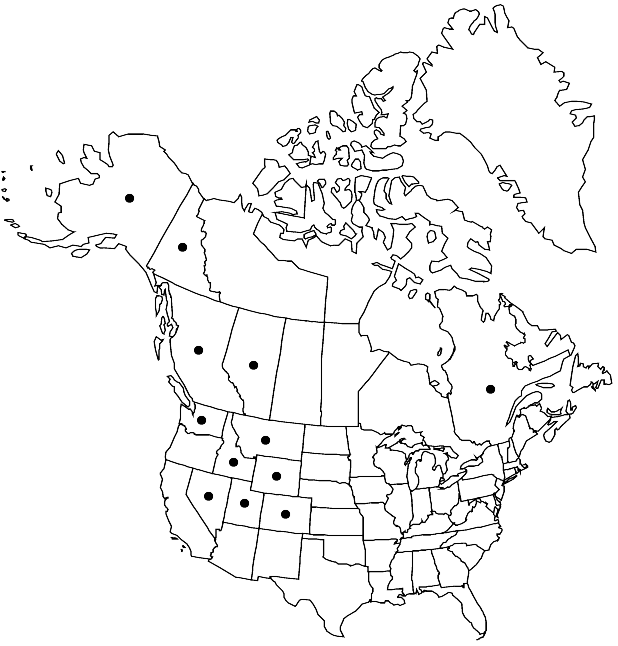Difference between revisions of "Draba incerta"
Amer. J. Bot. 4: 261. 1917.
FNA>Volume Importer |
FNA>Volume Importer |
||
| Line 11: | Line 11: | ||
|name=Draba exalata | |name=Draba exalata | ||
|authority=E. Ekman | |authority=E. Ekman | ||
| − | }}{{Treatment/ID/Synonym | + | }} {{Treatment/ID/Synonym |
|name=Draba incerta var. laevicapsula | |name=Draba incerta var. laevicapsula | ||
|authority=(Payson) Payson & H. St. John | |authority=(Payson) Payson & H. St. John | ||
| − | }}{{Treatment/ID/Synonym | + | }} {{Treatment/ID/Synonym |
|name=Draba incerta var. peasei | |name=Draba incerta var. peasei | ||
|authority=(Fernald) Rollins | |authority=(Fernald) Rollins | ||
| − | }}{{Treatment/ID/Synonym | + | }} {{Treatment/ID/Synonym |
|name=Draba laevicapsula | |name=Draba laevicapsula | ||
|authority=unknown | |authority=unknown | ||
| − | }}{{Treatment/ID/Synonym | + | }} {{Treatment/ID/Synonym |
|name=Draba peasei | |name=Draba peasei | ||
|authority=unknown | |authority=unknown | ||
| Line 38: | Line 38: | ||
|elevation=0-3300 m | |elevation=0-3300 m | ||
|distribution=Alta.;B.C.;Que.;Yukon;Alaska;Colo.;Idaho;Mont.;Nev.;Utah;Wash.;Wyo. | |distribution=Alta.;B.C.;Que.;Yukon;Alaska;Colo.;Idaho;Mont.;Nev.;Utah;Wash.;Wyo. | ||
| − | |discussion=<p>Draba incerta was shown by G. A. Mulligan (1972) to be sexually reproducing and 14-ploid with x = 8. It is often confused with the apomict D. oligosperma (2n = 32, 64). Draba incerta is readily separated from D. oligosperma by having well-formed (versus abortive) anthers and pollen, stalked (versus sessile) leaf trichomes, and ciliate (versus non-ciliate) basal leaves with obscure (versus prominent) midveins. Although both species have leafless scapes, one often finds a bract adnate to, or subtending, the proximalmost pedicel in D. incerta.</p><!-- | + | |discussion=<p><i>Draba incerta</i> was shown by G. A. Mulligan (1972) to be sexually reproducing and 14-ploid with x = 8. It is often confused with the apomict <i>D. oligosperma</i> (2n = 32, 64). <i>Draba incerta</i> is readily separated from <i>D. oligosperma</i> by having well-formed (versus abortive) anthers and pollen, stalked (versus sessile) leaf trichomes, and ciliate (versus non-ciliate) basal leaves with obscure (versus prominent) midveins. Although both species have leafless scapes, one often finds a bract adnate to, or subtending, the proximalmost pedicel in <i>D. incerta</i>.</p><!-- |
| − | --><p>Draba incerta is found near sea level in Alaska.</p> | + | --><p><i>Draba incerta</i> is found near sea level in Alaska.</p> |
|tables= | |tables= | ||
|references= | |references= | ||
| Line 63: | Line 63: | ||
|publication year=1917 | |publication year=1917 | ||
|special status= | |special status= | ||
| − | |source xml=https://jpend@bitbucket.org/aafc-mbb/fna-data-curation.git/src/ | + | |source xml=https://jpend@bitbucket.org/aafc-mbb/fna-data-curation.git/src/8f726806613d60c220dc4493de13607dd3150896/coarse_grained_fna_xml/V7/V7_414.xml |
|tribe=Brassicaceae tribe Arabideae | |tribe=Brassicaceae tribe Arabideae | ||
|genus=Draba | |genus=Draba | ||
Revision as of 17:57, 18 September 2019
Perennials; (cespitose, often pulvinate); caudex branched (dense with persistent leaf remains, branches sometimes terminating in sterile rosettes); scapose. Stems unbranched, (0.2–)0.4–1.4(–2.1) dm, often pubescent throughout, sometimes glabrous distally, trichomes often simple and 2–5-rayed, 0.1–0.5 mm, (sometimes with mostly subpectinate ones). Basal leaves rosulate; petiolate; petiole (0–1 cm), ciliate throughout; blade narrowly oblanceolate to linear, (0.4–)0.6–1.7(–2.5) cm × (1–)1.5–3.5(–5) mm, margins entire, (ciliate, trichomes usually simple, rarely 2-rayed, 0.2–1.1 mm), surfaces usually pubescent with short-stalked, pectinate trichomes, 0.15–0.5 mm, sometimes also with 4–6-rayed ones, (midvein usually obscure abaxially), sometimes glabrous adaxially. Cauline leaves usually 0 (or 1, as a bract); sessile; blade linear to oblong, margins entire, surfaces pubescent as basal. Racemes 3–14(–30)-flowered, usually ebracteate, rarely proximalmost flowers bracteate, elongated in fruit; rachis not flexuous, glabrous or pubescent as stem. Fruiting pedicels ascending, straight, (2.5–)4–11(–27) mm, glabrous or pubescent, trichomes 2–5-rayed or pectinate. Flowers: sepals broadly ovate, 2.5–3.5(–4) mm, pubescent, (trichomes simple and 2- or 3-rayed); petals yellow (fading white), oblanceolate to obovate, 4–6 × 1.5–2.5 mm; anthers ovate, 0.3–0.5 mm. Fruits broadly ovate to lanceolate, plane, flattened, 5–9(–11) × 2–4 mm; valves glabrous or puberulent, trichomes simple and 2-rayed, 0.05–0.3 mm; ovules 8–16(–20) per ovary; style 0.2–0.9 mm. Seeds oblong, 1.1–1.5 × 0.7–1 mm. 2n = 112.
Phenology: Flowering Jun–Aug.
Habitat: Rock outcrops, talus, gravelly areas, tundra
Elevation: 0-3300 m
Distribution

Alta., B.C., Que., Yukon, Alaska, Colo., Idaho, Mont., Nev., Utah, Wash., Wyo.
Discussion
Draba incerta was shown by G. A. Mulligan (1972) to be sexually reproducing and 14-ploid with x = 8. It is often confused with the apomict D. oligosperma (2n = 32, 64). Draba incerta is readily separated from D. oligosperma by having well-formed (versus abortive) anthers and pollen, stalked (versus sessile) leaf trichomes, and ciliate (versus non-ciliate) basal leaves with obscure (versus prominent) midveins. Although both species have leafless scapes, one often finds a bract adnate to, or subtending, the proximalmost pedicel in D. incerta.
Draba incerta is found near sea level in Alaska.
Selected References
None.